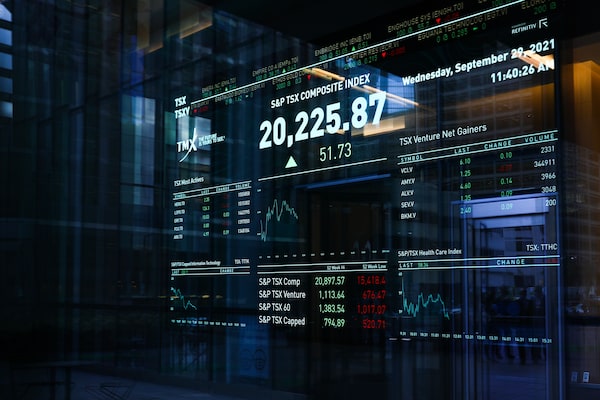
A sign board displays the TSX in the Richmond Adelaide Centre in the financial district in Toronto on Wednesday, September 29, 2021.Evan Buhler/The Canadian Press
The forceful market correction hitting technology stocks has helped turn Canada into one of the best venues in the world for equity investors, flipping the narrative that the commodity-heavy S&P/TSX Composite Index is a backwater in a world allegedly obsessed with environmental, social and governance principles.
Since the start of the year the S&P/TSX is relatively flat, losing only 0.6 per cent of its value. That is the second-best performance among major markets in the West, topped only by London’s FTSE 100, which has gained 1.9 per cent. The S&P 500 and Nasdaq have lost 6.1 per cent and 11.3 per cent, respectively, as investors find more reasons to dump shares of technology and other innovative companies. Meta Platforms Inc., the company formerly known as Facebook, is the latest to get punished, shedding 26.4 per cent of its value on Thursday.
Canada’s strength isn’t short-lived, either. The TSX is now also the developed world’s second-best performing index over the past year, delivering a 17.7 per cent return. France’s CAC 40 takes the crown with a 25.9-per-cent gain.
Despite the recent strength, many Canadians haven’t been willing to believe their good fortune. “Canadian investors are the moral equivalent to Eeyore,” Brian Belski, chief investment strategist at BMO Nesbitt Burns, said in an interview. “Constantly negative, constantly doubting, constantly fearful.”
Mr. Belski is in constant contact with Canadian investors of all sizes, and he’s found far too many are obsessed with saying we must be nearing the end of the economic – and stock market – cycle. He tells them Canadians should be “relishing in the green screens and the blue skies the TSX has delivered.”
For many years it was challenging for Canadian investors to get excited. Because Canada is a resource-heavy economy, energy and materials stocks used to dominate the S&P/TSX, accounting for 48 per cent of the index combined, but both sectors then crashed. The mining supercycle imploded in 2012, and oil and gas markets tanked in 2014.
“The majority of times, the makeup of the Canadian index is to Canada’s detriment,” Mr. Belski said.
Not now, though. Energy stocks have soared, with the sector delivering a 11.7-per-cent total return since Nov. 1.
Some of this strength stems from a quick rebound off multiyear lows. However, investors have far more to be excited about than a simple reversion to the mean. West Texas Intermediate oil, which is the benchmark for Canadian crude, traded at US$90 a barrel on Thursday, its highest level in eight years. Many Canadian energy producers are awash in cash flow – and even in the ESG era, investors are ecstatic.
Canadian stocks also have multiple structural advantages right now, says Lesley Marks, chief investment officer for equities at Mackenzie Investments. The energy and mining sectors have lacked investment for many years, which means production is struggling to keep up with resurgent demand; global growth is still rebounding and there is a continued cyclical recovery; and rising interest rates are punishing high-flying growth stocks, while benefiting financial institutions – particularly banks. Financials comprise 32 per cent of the TSX, and have delivered a 9.7-per-cent total return since Nov. 1, which is when the recent growth stock crash began.
All these factors “set us up for pretty favourable fundamentals for the majority of Canadian stocks,” Ms. Marks said in an interview.
Although Canada is expected to hold its own this year, relative to other markets, the range of expected returns varies wildly. Because so much is likely to change as central banks raise rates, some strategists believe a “good” year may only mean muted gains.
Yet even in that scenario, Canada has an advantage. “Dividends (now classified in a passé group along with ‘Your Father’s Oldsmobile’) will return to prominence,” market strategists at Canadian Imperial Bank of Commerce wrote in a recent note to clients. “Remember, dividends have traditionally made up 25 per cent to 35 per cent of equity returns in the longer term.”
The TSX’s dividend yield is currently 2.6 per cent, roughly double the S&P 500′s at 1.35 per cent. “In a single-digit-return world, even an extra 100 basis points of dividend yield will be a difference maker,” the CIBC strategists wrote.
Your time is valuable. Have the Top Business Headlines newsletter conveniently delivered to your inbox in the morning or evening. Sign up today.
 Tim Kiladze
Tim Kiladze